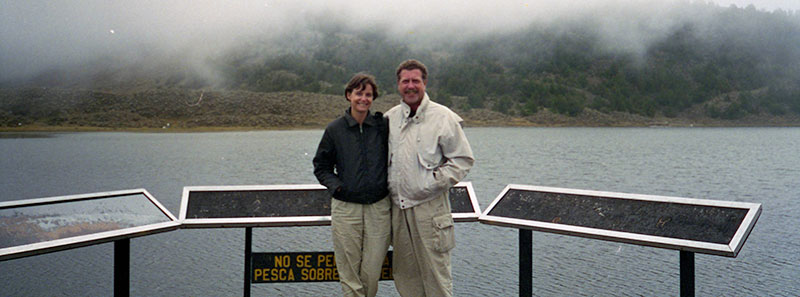Merida and the Andes Mountains
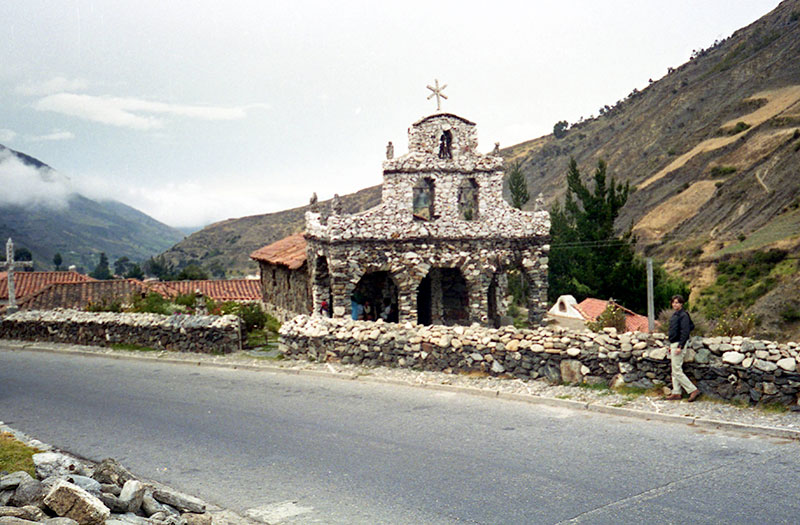
An amazing Dry Stone Church High up in The Andes Mountains near San Rafael.
We fancied a trip to the Andes Mountains while we were anchored off of Puerta La Cruise, Venezeula. So the first order was to secure Toucan at the marina as there was a lot of theft in the area. And an unattended boat anchored off in the bay was an easy target. Whenever the Venezuelain economy was in dire straits, there was a lot of crime happening. Even the marina was surrounded by razor wire and the guards on the front gate were armed with automatic weapons. Bank guards, were similarly armed. When you made even the smallest bank transaction, your photograph was taken by the film roll cameras installed at each teller. This may sound like a place to be avoided, but this was something you got used to. And Puerta La Cruise was the tourist town on the North Coast, and was far better than most.
We arranged for a slip at the marina, and shut the boat down, and prepared for a visit to Merida, a university town (Universidad de Los Andes) high up in the Andes Mountains that was popular with the yachties. It was a simple matter of going to the main square, where the busses all congregated. And ask Merida? Si, Quanta est (how much). Hop on and off you go. The fares in Venezuela were about 60 miles to the U.S. dollar, and it was easy to judge if the fare was fair, or was it Greengo prices. My Spanish was not the best and most times the price quoted was spoken to fast for me to translate quickly, so when this happened, I would just repeat what the driver had just said but with a disapproving look and a shake of my head. And then they would always say a lesser amount, which gave me time to figure out exactly what the price quoted was, and then convert it to U.S. funds. I had no idea what the actual local price should be. This method seemed to work very well, especially when buying something in the market squares. When getting a taxi in Puerta La Cruiz, the taxis were common transport, which meant that they would fill the taxi with other passengers along the route. Every one would pay a much lesser amount – sort of like a small bus. But if you flagged down a taxi anywhere else other than on a taxi-bus stand, you automatically were hiring a private taxi. The same vehicle, but this time they would not pick up any other passengers. And of course the price would be 10 times the amount for the same distance traveled. The trick the taxi drivers were using was when they saw a couple of what looked like tourists (read Gringo) heading for the taxi-bus stand, the lead taxi (which is the one everyone gets into next) would slowly pull ahead a foot or two and be very slightly out of the official taxi-bus stand, you would hardly notice this, but he is now a private hire taxi, and would charge 10 time the going rate. After living in Venezuela for over a year, you get wise to these annoying tricks, and learn to deal with them. Usually by walking right past the lead taxi who thinks he is getting one over on you, and getting into the second one, who by this time has pulled up towards the rear of the lead taxi. and now the lead taxi cannot back up, and is a private hire, to which none of the locals will get into. Stuffed – when in Rome …

Deb standing at the statue of Simon Bolivar in Plaza Bolivar, Merida.
The local currency was the Bolivar, named after Simon Bolivar the liberator of Venezuela from the Spanish. And his statue is in every or village or town square. He is reviled in this country, and woe betide the tourist who disrespects the statue of Simon Bolivar. Simple things like walking past inappropriately dressed – wearing shorts or a bathing suit, or carrying furniture, or any inappropriate behavior in the immediate vicinity – openly drinking alcohol and so on. And the last thing you want to do is let the local authorities have something over on you, as the longer you are in the system, the more officials you will have to bribe and the higher the cost will be to get out. This is just the system there. So it is better to apologise for any infraction and ask to pay any fine right on the spot. Once you are aware of how things work then it is simple to avoid any misunderstanding, and we never had any problems. The official exchange rate at the time was 40 Bolivars to one U.S. Dollar (at the bank), but you could get 400 to 1 on the street, or selected shops. One shop was a travel shop in Porlamar, Margarita Island. And it was done with utmost discretion. Which meant that there was no counting of the amounts, which lead often to one or 2 notes missing in the exchange. This even happened to us once in the bank. The bundles of money that had a bank strip seal, was short one note, as I discovered when I finally got a chance to count it. we always considered this “Tourist Tax”
We packed a backpack and hiking boots and the usual t-shirts, waterproofs, warm jacket (for cool evenings), large knife in a sheath, toiletries, energy bars, cockroaches spray, Tilley hats, extra socks, travel alarm clock, passports, and a wad of “smalls” – small denomination currency in Bolivars, which didn’t total much, but looks the part wrapped in a few 100 bolivar notes. This was always carried in the front pocket and was for just in case we were robbed. With the idea that if you offer no resistance and handed over your “wad” of cash, they were off in a flash. We never had to use our “wad”, as we were always aware of our surroundings, and always kept an eye out. Now this sounds like we were paranoid, but some of the places we were traveling through were pretty remote and well of the tourist routes. We always had the high denomination notes, in a variety of locations throughout our back pack and in different places on us. So if a few were discovered, we would still have some to carry on with. In contrast to all this, I must say, almost all the Venezuelans we encountered were very friendly and could not do enough for you. We even had a woman who we were asking where the local Laundromat was located, instructed her 9 year old son to take us the 6 blocks to the Laundromat, to make sure we got there okay.

Willie at Las Chincheras covered in mud.
So off we went from Puerto La Cruise and our first planned stop was the health spa – Las Chincheras, 18km North of Valencia, built on top of some natural hot mud springs. The 2nd hottest mud springs in the world – 198 Deg F., (the hottest being in Japan). I had been visited by the explorer Humboldt who used to boil his eggs in the natural water. It was a bit difficult to find after we were dropped off the bus on the highway, in what looked like the middle of nowhere. But after some searching we found the spa down a residential street. This was a pleasant surprise. The hotel and spa were built in 1899, and renovated in 1980, and it was very well maintained. We booked a room for a night for the total amount of $2.50 for the both of us, surprised we booked another night. This included maid service and fresh towels and a bucket of ice and bottled drinking water, and coffee makings and cable TV (all in Spanish). The grounds started on the top of the hill with the mud (lodo) in a communal bowl, and a series of large size pools working their way down the hill (starting at 98 Deg F.), each with progressively hotter water culminating in a giant pool at the bottom of the hill, with the hottest water (118 Deg F.). At the top of the hill where the communal bowl was located there was cooled mud, that allowed you to cover yourself from head to toe, with what was special therapeutic (looked like little specs of silica) saturated mud which was considered to give you some sort of health benefits. When in Rome … After lying around for a while in this quickly drying mud coating, you could wash it off in a special rinsing pool. And then progress down the pools to the lowest pool and after acclimatising to the temperature, and relax away the day in the therapeutic waters. I found I could only stay in the hottest pool for only about 10 minutes before it became unbearable. And had to go and rinse in the cool water showers. There were tourists there that we observed to be in the hot pool for hours.The place was full of Japanese tourists, and a few local Venezuelans.
Then it was off to the Andes Mountains and the town of Merida. We took a taxi to the local town square where we could get a bus to Merida. There was the only train station not too far, that only had one line, and according to the guide book The Lonely Planet, it ran only on one day a week, and that was only for an hour each way. And that was today. Since it was early in the day, we thought that we would walk to the train station and take a trip. When we arrived the train day had been moved and the train station was closed. So we took a few photos anyway and proceeded back to the local bus station, as we were walking away I noticed a small group of older teenagers hanging around to the side of the train station. One approached us and asked in Spanish why we were travelling alone and not worried about being robbed? I told him in my sporadic Spanish that we were armed with a pistola and would just shoot any bastard stupid enough to try and rob us. As he went back and relayed this information to his friends, I said to Deb right let’s make tracks as quickly as possible without seeming to run. as I certainly did not have a pistola in my bag. But they did not know this. And we had been to a few gun shops in Puerto La cruise, and had a look at what was available. So I imagine, like the U.S. a lot of people carried personal fire arms. We got to the packed bus terminal in short order, where there was safety in numbers.
We managed to get space on a small bus going to Merida, but were one of the last passengers to board, so all the seats were taken and we had to sit on the chicken coups at the back. I now know why these were still available at the back. As every time we hit a large bump in the road Deb and I and the chickens were airborne. Luckily they had wings – we didn’t – ouch! This made for a very long trip up the Andes Mountains. There was one section that was all switchbacks, going up the mountain from the coast – the typical – S – shape going back and forth continuously for 4 hours. Every so often we had to swallow to clear our ears. Finally we leveled off at 14,000 feet. There were no trees anymore and the only features in the surrounding hills were a few clusters of observatories. The bus stopped to let the passengers off to stretch their legs, and to get a coffee at the small stand. The only coffee available was coffee pequeno – a very small 3 ounce container of extremely strong coffee, meant to be drunk in a oner. After 2 of these I ran up one of the nearby small hills and had a cigarette. Boy what a buzz!
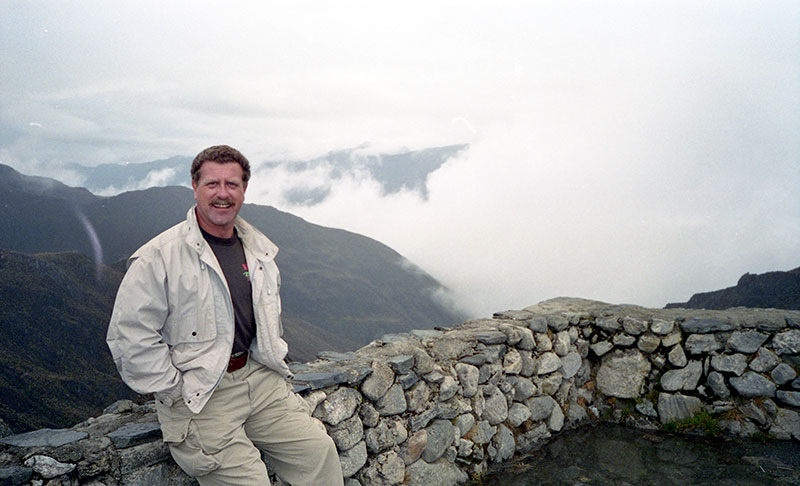
Willie at a lookout point, with the clouds far below.
Back on the bus and a few hours later we arrived in Merida (Santiago de los Caballeros de Mérida). This is a university town (University of Los Andes), with a claim to fame for having the highest and longest cable car in the world. It was closed when we were there as one of the cars had recently detached from the cable and had disastrous consequences. They have recently replaced all the infrastructure after an 8 year shutdown and re-opened in 2016. We found a local youth hostel to stay in and it had a central court – which was the living room, with couches and chairs and a large TV. We were in a room just off the living room with a large window facing the living room TV. We could lie in bed and open the curtains and watch the TV with everyone when we wanted to. Beauty! Keep in mind that we had not seen many movies on a large TV for many years. The price for staying per night was US $5 for the both of us. So we could easily afford a few nights to chill out. There were loads of interesting restaurants around and the most popular fare was locally caught trucha (trout), trout with lemon, trout, with chillis, trout with – you get the idea. Deb even had trout with raspberry sauce! While exploring the town one evening, we could hear a live performance of a rock band drifting through the old part of town, and all they were playing was Queen songs – in English. This was too good to be true and had to be investigated. So off we went in the direction of the sound and sure enough there was a live tribute band playing in one of the main plazas surrounded by a large crowds of students. All rocking to “Another one Bites the Dust” This place was great!
We decided that the quickest and most economical way to see the Merida area was to hire a local guide with a car and do a little tour. We found Lisette, a local guide that was willing to do this kind of tour. So off we went for the day. We visited the dry stone church, that is the lead photo for this article. The interesting thing about this type of construction is there is no mortar used between the stones. we see this in Scotland all the time with boundary walls – and is called Dry Stane. It pays testament to this construction method, as I wonder how it has survived earthquakes for many years.

A Condor with a 10 foot wingspan is on display in the Andes Mountains.
We went more off the beaten path and visited a village high up in the mountains and saw how the villagers lived. There was an interesting display of a live Condor in a very large cage not too far. From what we could understand the display was so that the locals could get to see a Condor close up and see how they lived. As the local belief was that Condors snatched and killed small farm animals and even children. Condors are very large vultures, with a wingspan of 10 feet. And as a result, local farmers were apt to shoot the Condors. This was one of the reasons the Condors in the Andes mountains were on the endangered species list. they were slow to mature and lived very long lives if left alone. And the display was an attempt to re-educate the locals. To show them that they only seek large pray that was already dead, and in fact had started to decay. They could sense the gases given off, early in this process. And that is how they locate their pray. These scavengers were natures clean up patrol, and consumed any carrion. And as a result reduced the chances disease spreading. Which was a good thing.
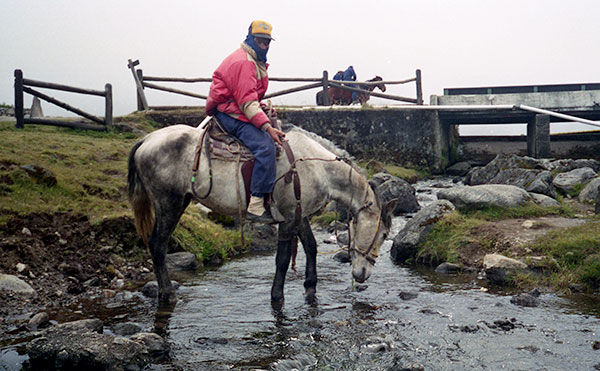
A well wrapped llaneros horseman stops by a stream to let his horse have a drink.
We came across some llaneros or chagra / gouchos horsemen (South American Cowboys) and one had stopped in a stream to let his horse have a drink. You could see how cold it was by their attire – well padded. And this was in the summertime 10 degrees above the equator, what must it be like in the wintertime! There was also plants nearby that had thick furry leaves that were also able to withstand the cold temperatures We seemed to be always in the clouds we were so high up, now I realise that is what we in Scotland call mist, which makes it even colder and damper.
In the village, the children learn to ride horses from an early age. This would be comparable to U.S. kids learning to ride a bike at an early age. This seemed to be the preferable mode of transport for children and adults alike, as there was only one road, and not many cars, and a vast mountainous territory. I can’t imagine what it would be like getting around when it was covered in snow. I found it a little difficult to catch my breath at this altitude and I found myself tiring a little quicker. Which made for a good excuse to stop whenever we could for a pequeno coffee. That stuff is addictive! Bing – you’re AWAKE!
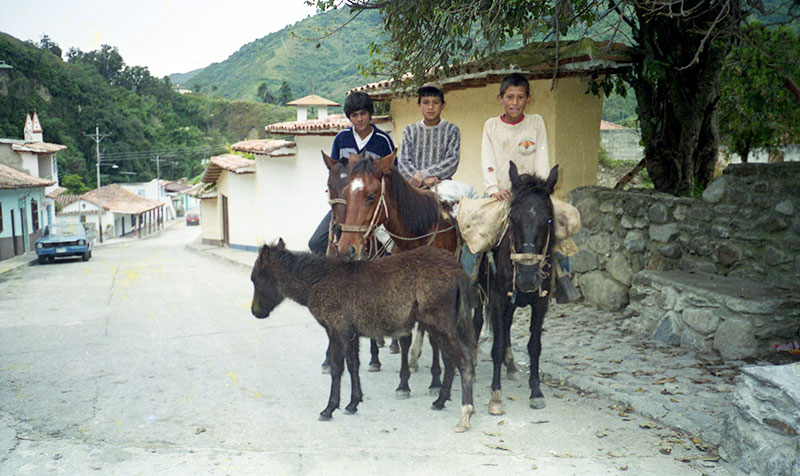
Children on horseback, a common sight in the village.
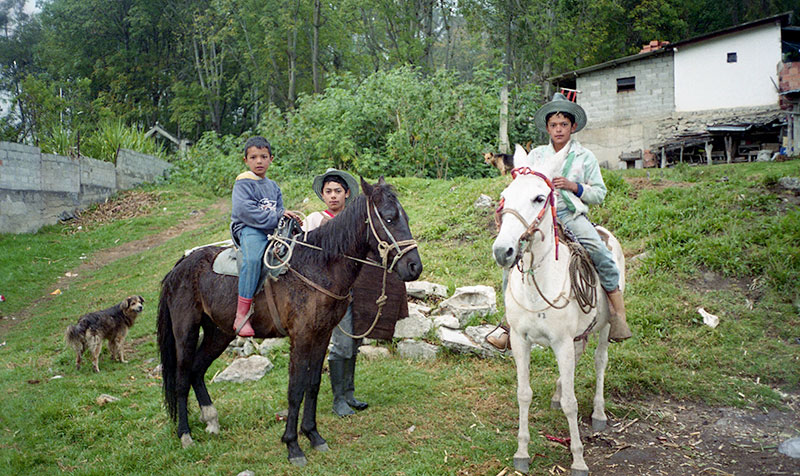
Children learn to ride horses at an early age in the mountains.
All the kids had rosy cheeks, and Lisette explained that this was because of the high altitude that they live in all their lives, and that all the children were similarly affected. We came across a couple of children who were willing to pose for a picture, and I asked them to sit by the flowers in their garden, as it would make for a great shot. They were happy to do so. and after I had taken my picture, the little boy on the left in the picture, with the Alpine hat on, came over and with his hand out demanding 50 Bolivars for payment for taking his picture – a 5 year old! Boy, do they learn quick. Our guide Lisette had to laugh. Even the kids are working the tourists. I gave him 10.
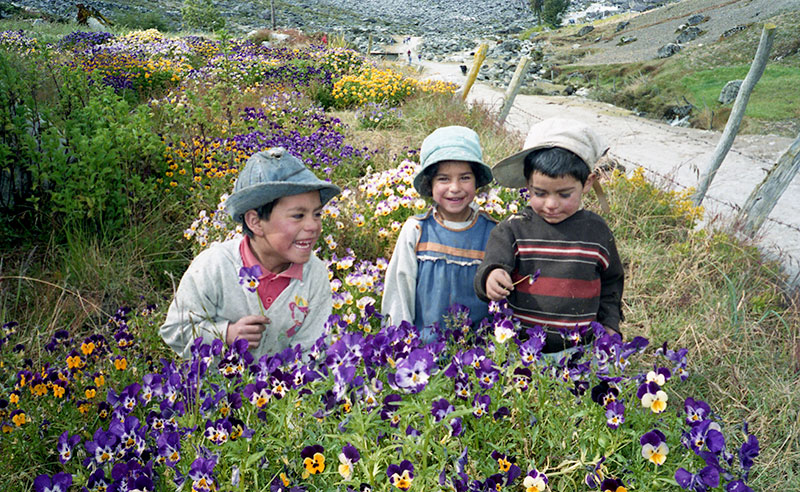
Rosy cheeked children sitting among the posies in the Andes.
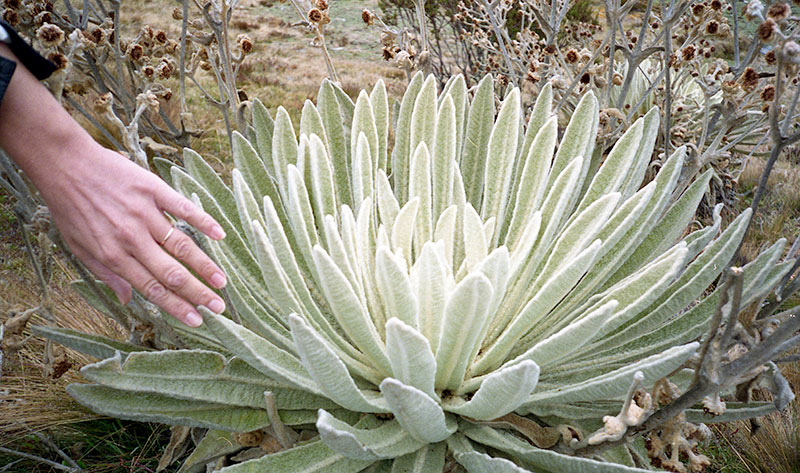
This furry plant survives the low temperatures of the Andes
It seamed that every where we turned there was a photo opportunity. I wish we had our digital cameras back then instead of a simple traveling film camera. The locals all seemed friendly, and were patient and would pose for a quick shot. There seemed like endless kids in the village.
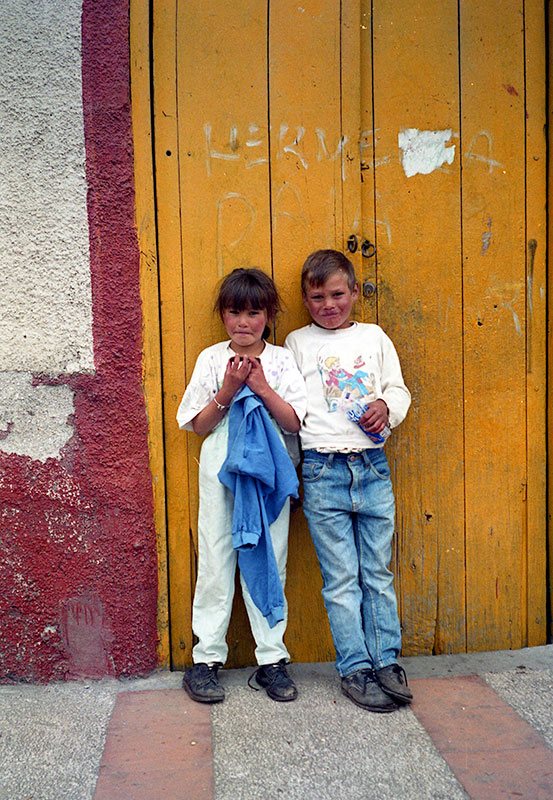
Every child had red cheeks. These two posed against a colourful door.
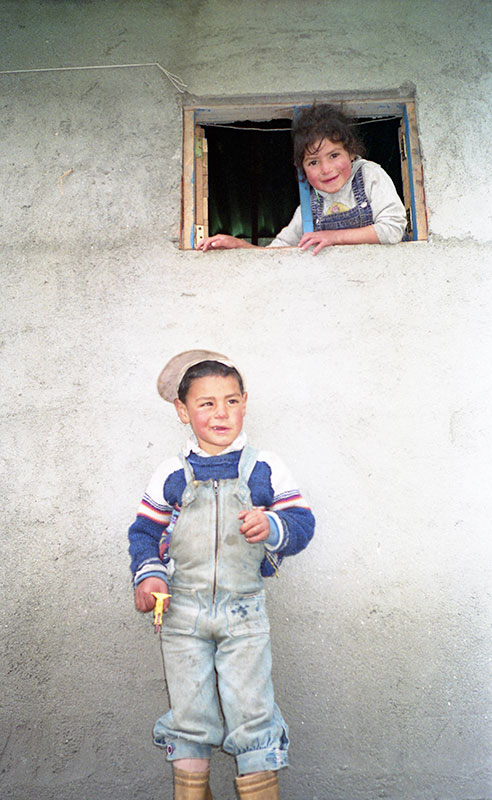
This cheekie chappie wears his baseball cap in the popular way.
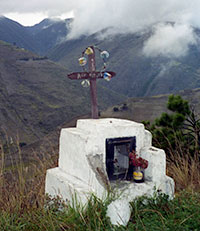
Roadside Shrine.
I noticed that there were little shrines at certain points along the mountain roads. Especially where there was a sharp bend. Lisette said they were where someone had died after going off the mountain edge, usually in a vehicle of some sort. And these were built and maintained by the families or relatives of the dead. On the way back to Merida we had to stop off at Lisette’s house, and while we were there I noticed that her family had several refrigerators and a half dozen washing machines and dryers and freezers, All brand new and still in plastic and most were still boxed. Lisette explained that the economy was so bad and some banks were failing, and inflation was extremely high that it was not worth putting your money in a bank, only to watch it slowly disappear or worse still suddenly disappear. So their solution was to take the money out of the bank and buy as many white appliances as they could. Ones that were always in demand, and sell them off when they needed money. This guarded against inflation as they would sell them at the going rate, and they were not going to disappear overnight like some of the banks did. We had a great day and thanked Lisette for taking us all around and giving us an insight to how the Venezuelans lived.
Jají (Estado de Mérida)
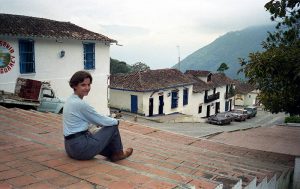
Deb taking a breather in Jají (Estado de Mérida).
After a few days, we were hoping to see a little more of the Andes Mountains, on our own, so packs on back and off to the local bus terminal and a hop on one of the local small buses and we were off to a mountain village. We stopped of at Jaji (pronounced Haji). There we found a hacienda who’s main business was producing coffee, and had a little coffee shop on the side. They also have a small selection of local food on offer. They spread the coffee beans in the central square to dry out and would “stir” the beans with a large wooden rake every now and then. While trying some of the local “squeaky” cheese – cheese that when you took a bite would squeak between your teeth. We noticed that they also had a few rooms to rent for the travelers. And yet again the price was very reasonable U.S. $5 for the two of us for the night, and that included a mountain breakfast. So we went ahead and booked a room.
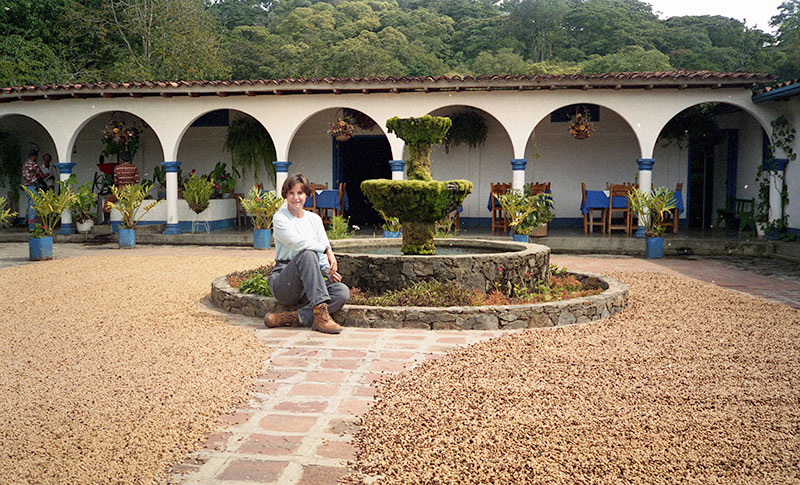
Deb posing at the central fountain in the central square of the hacienda surrounded by coffee beans drying in the sun. The breakfast tables are behind under the arches.
The view from the outside coffee shop was spectacular, as the landscape just dropped away down the mountain, and into the clouds below. In the afternoon we went for a walk around the town. There is always a church built in 15 something or other, and there is the obligatory Simon Bolivar statue to have a look at. The village was very quiet as there was not much happening at all. So we returned to the hacienda to have a wash and freshen up before supper. We ordered supper – the usual chicken of some sort, and rice and beans. One of these days we will learn some more Spanish other than Pollo, arroz y frijoles. and Hamburguesa con queso y una cerveza, por favor, these two have always served us well, with “Jamón asado y sandwitch de queso” as my fall back meal – lol. While we were waiting for the meal to arrive Deb did a little posing for the camera. And took a turn de-husking the dried coffee beans from the courtyard. We had a delicious supper with a few interesting condiments, and after a few “Cuba Libres sin limon” – (rum and coke) as the lemon slices always gave me heart burn, we retired to our small room.
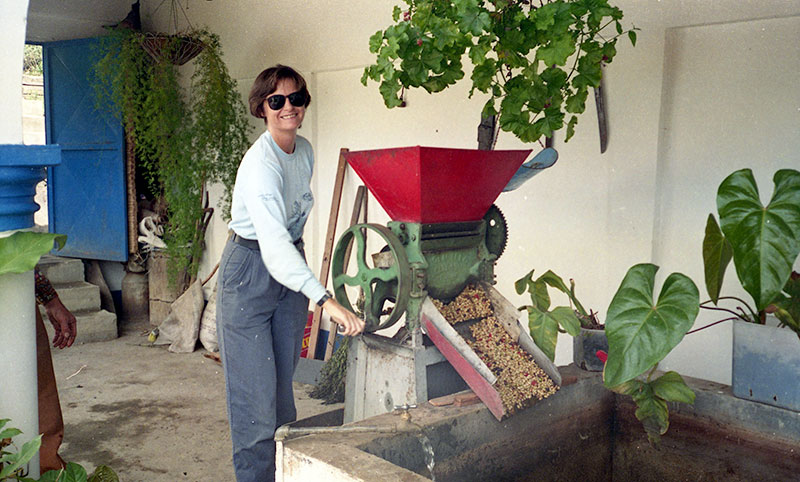
Deb de-husking the coffee beans from the courtyard.
We were up at the crack of dawn with an appetite, and after a breakfast which consisted of fried squeaky cheese, ham and lots of flat bread, all washed down with lashings of coffee, we were raring to go. We explored the rest of the village before catching the 8:00 am bus back to Merida.
We stayed in Merida for a few days relaxing and checking out the vibrant town. We took time to do the interesting tourista highlights like the Catedral Metropolitana de Mérida – the large Cathederal in town, and hung around the Plaza Bolivar people watching, different peoples and different cultures- amazing.amount to observe.
It was too soon time to leave and go back to our sailboat in Puerta La Cruiz. We decided to take the express bus back to PLC directly from Merida, as this would mean that we did not have to spend the night in Caracas, which we did on the way up to the Andes. We found Caracas to be an unpleasant experience. There must have been a garbage strike on, and the air was foul. The hotel we booked into gave us a room that the door could not be secured due to the lock being broken, so we insisted on another room. The new room was stiffing, even with the windows fully open, and with the windows open the stench and noises from below made it even worse. We have stayed in some pretty basic accommodation, from sleeping in hammocks in the Amazonian Jungle, where you hung everything up in your hammock away from the floor including your boots, and checked them in the morning for tarantulas or snakes before putting your feet into them.To hostels that were over run with cockroaches that we had to fumigate the room and go away for a few hours before returning. Which was fair game for the places we were staying at. You just take it in your stride, as things you needed to do. But Caracas was on a whole other level. So off to the express bus it was (the lesser of the two evils).
There are a couple of things you should be aware of if you are going to take an intercity bus in Venezuela. The first thing is they have the air conditioning up, and I mean up full! The second thing is the music from the $10 stereo is also turned up full. For the whole trip – all 12 hours. You may think I am joking, but I am not. I do not know if it is a cultural thing, or something. But nobody complains. If you have ever owned a cheap stereo and tuned it up full, to the point where it will not go up any more and the music is distorted and really loud, you get the idea. I can understand really loud if you are at Carnival in Trinidad, which we have survived and enjoyed 9 times. But at least it was not badly distorted like it was on this bus. We were well prepared as we had brought earplugs. We have been on a few bus trips in Venezuela. And cold, that does not describe it. We put on every piece of clothing we had in our backpacks. and got under our space blankets. Every one on the bus has 2 or 3 blankets on top of them. And nobody asked the driver to turn either one down, and I did not hear anyone complain to each other either (well you couldn’t with this volume). They just seemed to accept it as normal. It is the strangest thing I have ever come across. Different strokes for different folks indeed!
Needless to say we were glad to be at the bus stop back in Puerta La Cruiz. Overall the trip was great, the scenery was spectacular, the people were very friendly, the food was mostly passable and on occasion very good, and sometimes very interesting in a good way. The accommodation was basic but clean. I’m glad we went!
4,562
